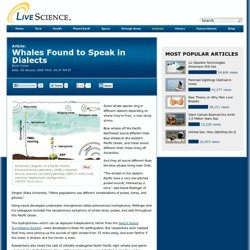Animal communication
> Science
> Animals
Whales Found to Speak in Dialects. Some whale species sing in different dialects depending on where they're from, a new study shows.

Blue whales off the Pacific Northwest sound different than blue whales in the western Pacific Ocean, and these sound different than those living off Antarctica. And they all sound different than the blue whales living near Chile. "The whales in the eastern Pacific have a very low-pitched pulsed sounds, followed by a tone," said David Mellinger of Oregon State University. "Other populations use different combinations of pulses, tones, and pitches.
" Using newly developed underwater microphones called autonomous hydrophones, Mellinger and his colleagues recorded the cacophonous symphony of whale clicks, pulses, and calls throughout the Pacific Ocean. The hydrophones—which can be deployed independently rather than the Navy's Sound Surveillance System —were developed to listen for earthquakes. Researchers don't know why whales around the world sound differently. MORE FROM LiveScience.com. The Discovery of Dolphin Language. Researchers in the United States and Great Britain have made a significant breakthrough in deciphering dolphin language in which a series of eight objects have been sonically identified by dolphins.

Team leader, Jack Kassewitz of SpeakDolphin.com, ‘spoke’ to dolphins with the dolphin’s own sound picture words. Dolphins in two separate research centers understood the words, presenting convincing evidence that dolphins employ a universal “sono-pictorial” language of communication. The team was able to teach the dolphins simple and complex sentences involving nouns and verbs, revealing that dolphins comprehend elements of human language, as well as having a complex visual language of their own.
Beluga whale 'makes human-like sounds'
22 October 2012Last updated at 12:02 ET Beluga whales are known as "canaries of the sea" because of their frequent, high-pitched calls Researchers in the US have been shocked to discover a beluga whale whose vocalisations were remarkably close to human speech.

While dolphins have been taught to mimic the pattern and durations of sounds in human speech, no animal has spontaneously tried such mimicry. But researchers heard a nine-year-old whale named NOC make sounds octaves below normal, in clipped bursts. The first mystery, though, was figuring out where the sound was coming from. When a diver at the National Marine Mammal Foundation in California surfaced saying, "Who told me to get out?
" The whales are known as "canaries of the sea" for their high-pitched chirps, but while a number of anecdotal reports have described whales making human-like speech, none had ever been recorded.
Once they identified NOC as the culprit, they caught it on tape. In short, the mimicry was no easy task for NOC.
Banded mongooses structure monosyllabic sounds in a similar way to humans. Animals are more eloquent than previously assumed.

Even the monosyllabic call of the banded mongoose is structured and thus comparable with the vowel and consonant system of human speech. Behavioral biologists from the University of Zurich have thus become the first to demonstrate that animals communicate with even smaller sound units than syllables. When humans speak, they structure individual syllables with the aid of vowels and consonants. Due to their anatomy, animals can only produce a limited number of distinguishable sounds and calls.
Complex animal sound expressions such as whale and bird songs are formed because smaller sound units – so-called "syllables" or "phonocodes" – are repeatedly combined into new arrangements. Single syllable provides information on the identity and activity of the caller The research was conducted on wild banded mongooses at a research station in Uganda. Structured single syllables in animals not an exception? More information: David A.W.A.M.
Dolphins Call Each Other By Name. Bottlenose dolphins call out the specific names of loved ones when they become separated, a study finds.

Other than humans, the dolphins are the only animals known to do this, according to the study, published in the latest Proceedings of the Royal Society B. The big difference with bottlenose dolphins is that these communications consist of whistles, not words. Earlier research found that bottlenose dolphins name themselves, with dolphins having a “signature whistle” that encodes other information. It would be somewhat like a human shouting, “Hey everybody! I’m an adult healthy male named George, and I mean you no harm!” The new finding is that bottlenose dolphins also say the names of certain other dolphins. “Animals produced copies when they were separated from a close associate and this supports our belief that dolphins copy another animal’s signature whistle when they want to reunite with that specific individual,” lead author Stephanie King of the University of St.
Researcher decodes prairie dog language, discovers they've been talking about us (Video)
You might not think it to look at them, but prairie dogs and humans actually share an important commonality -- and it's not just their complex social structures, or their habit of standing up on two feet (aww, like people).

As it turns out, prairie dogs actually have one of the most sophisticated forms of vocal communication in the natural world, really not so unlike our own. After more than 25 years of studying the calls of prairie dog in the field, one researcher managed to decode just what these animals are saying. And the results show that praire dogs aren't only extremely effective communicators, they also pay close attention to detail. According to Dr. Con Slobodchikoff, who turned his vocalization analysis on the Gunnison's prairie dog of Arizona and New Mexico, the chirps these animals use as 'alert calls' are actually word-like packages of information to share with the rest of the colony. And, when they're talking about humans, that might not always be flattering.






